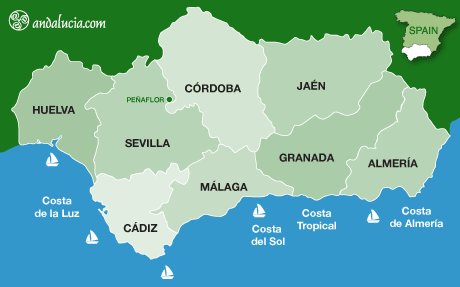PEÑAFLOR
by Saskia Mier
Peñaflor is located at the north east border of the province of Seville. Visitors to the town should pass by the eighteenth century, Iglesia de San Pedro, which has some beautiful neoclassical altarpieces and gold work. It has about 3600 inhabitants.
HISTORY
Peñaflor was already known by the name of Celti in the Iberian-Turdetan period. The Romans traded oil through the River Guadalquivir and pottery industry. Following the Visigothic period, the town enters a period of decay that lasts several centuries, until reborn during Muslim ruling.
Once the Castilian conquest took place in the thirteenth century, the Mudejar Torre de Villadiego was erected. An agricultural revival and population growth took place in the eighteenth century.
During the nineteenth century, as from the territorial division of Spain created by Javier Burgos in 1834, Peñaflor depended on the province of Seville, having been until that moment under the jurisdiction of Cordoba. In the second half of this century, the local economy is revitalized with the arrival of the railroad, flour mill and exploitation of the "La Preciosa" copper mine.
The copper mine closed in the mid-century due to poor profitability of the ore and the flour mill by the diversion of the River Guadalquivir during the 1963 flood. In the 1960s, it became part of the Bembézar Regime, which involves the founding of two settlements, Vegas de Almenara and La Vereda, thus revitalizing the economy of the area.
Hotels
Book hotels in Peñaflor
THINGS TO SEE
Yacimiento Archaeológico
An archaeological site that shows there was an uninterrupted human settlement for more than 1000 years, from the eighth century B.C. until the fifth century D.C. Located on Calle Nueva.
Recinto Amurallado y Cuevas
The remains of an almohade castle built in the twelfth century as the centre of the medieval city. The conserved caves were originally used for burial in a Roman necropolis, but today are used as storage rooms by the owners of the houses located under the walls of the medieval castle. Located on Calle de las Cuevas.
Ermita de Los Santos Mártires
The chapel was built in the eighteenth century next to a Roman tomb excavated in the rock. Located on Calle Blancaflor.
Convento de San Luis del Monte
The Baroque convent was built in 1766 for the Order of San Francisco, to the devotion of San Luis, Bishop of Tolosa. Today, only two of the walls remain. Located on Calle Juan Carlos I.
Ermita de la Encarnación
The eighteenth century chapel has a presbytery with Baroque dome decorated with plasterwork, dating to 1766. After having been restored, it now holds conferences, exhibitions, concerts, etc. Located on Calle San Pedro.
Iglesia de San Pedro Apóstol
The church began its construction in 1780, in the same site in which the previous one had been, and lasted 21 years until 1801.The duration of the works was 21 years, from 1780 to 1801 and stood six years, from 1788 to 1794, due to the unstable dome. Located on Calle San Pedro.
Casas Palacios
Emphasized within the civil architecture are Casa Cuartel and Casa Rectoral, both of the eighteenth century. The facades, in spite of their great austerity, represent the Baroque Sevillian style. Located on Juan Carlos I.
Fabrica de Harinas
The flour mill was inaugurated in 1878, after seven years of construction, called Sobrinos de Peña y Primo. In 1908 it was sol onto another family who exploited it and installed modern systems within it, remaining active until the mid twentieth century. Located on the river bank, opposite the train station of Peñaflor.
THINGS TO SEE OUTSIDE THE VILLAGE
Castillo de Almenara
A castle with a defensive construction of the Moorish era. In 1182, Alfonso VIII seized the Castillo de Setefilla and, in 1189, the Castillo de Almenara. Currently it is in an unfortunate state of deterioration and abandonment. Located at Km. 4.7 on the SE-140, from Peñaflor to La Puebla de los Infantes, through a gate with the name 'El Castillo'.
Ermita de Villadiego
The Mudejar chapel was built at the end of the thirteenth century or beginning of the fourteenth century. A medieval tower, Torre de Villadiego, attaches onto the chapel and the entrance courtyard has a collection of Roman archaeological pieces. Located west of Peñaflor, on the A-431.
El Higuerón
A pre-Roman cyclopean building whose origin and function are not entirely clear. It is suggested to have been constructed during the Iberian-Turdetano period and due to preserved archaeological remains, it was a raised building used as a restraint and defence against the floodwaters of the river. Located on the river bank, south of the Peñaflor.
COUNTRYSIDE WALKS
Peñaflor offers wonderful landscape to be enjoyed by all nature lovers, including Ruta Blas Infante, Camino Jacobeo de la Frontera and Gran Vega de Sevilla.
GASTRONOMY
The gastronomy is particularly something to look forward to in Peñaflor. Try the traditional Andalusian breakfast, local oven baked bread accompanied by olive oil from the area and home grown tomatoes. Game meat such as partridge and rabbit are very popular and typically stewed such as, guiso de perdiz o conejo. One must not forget the locally grown asparagus and artichokes, as well as migas (fried bread). For dessert, try the gachas (similar to semolina) and home grown oranges.
FESTIVALS
Cabalgata Reyes Magos
Three Kings procession celebrated on the evening of 5 January.
Las Candelas Celebrated on the 1 February.
Día de Andalucía Celebrated on the 28 February.
Carnaval Celebrated the 13 and 14 February.
Semana Santa Holy Week.
Feria de Vegas de Almenara Celebrated the 15-17 May.
Romería y Feria Celebrated the 14-17 August.
Festividad de la Encarnación Celebrated on the 8 September.
Día de la Constitución Celebrated on the 6 December.
Día de la Inmaculada Concepción Celebrated on the 8 December.
NEXT PLACES
The next villages to Peñaflor are Palma del Río, Lora del Río and La Puebla de los Infantes.
Book your stay in Andalucia Now!
